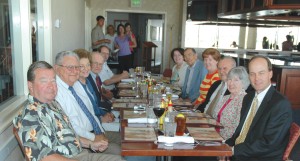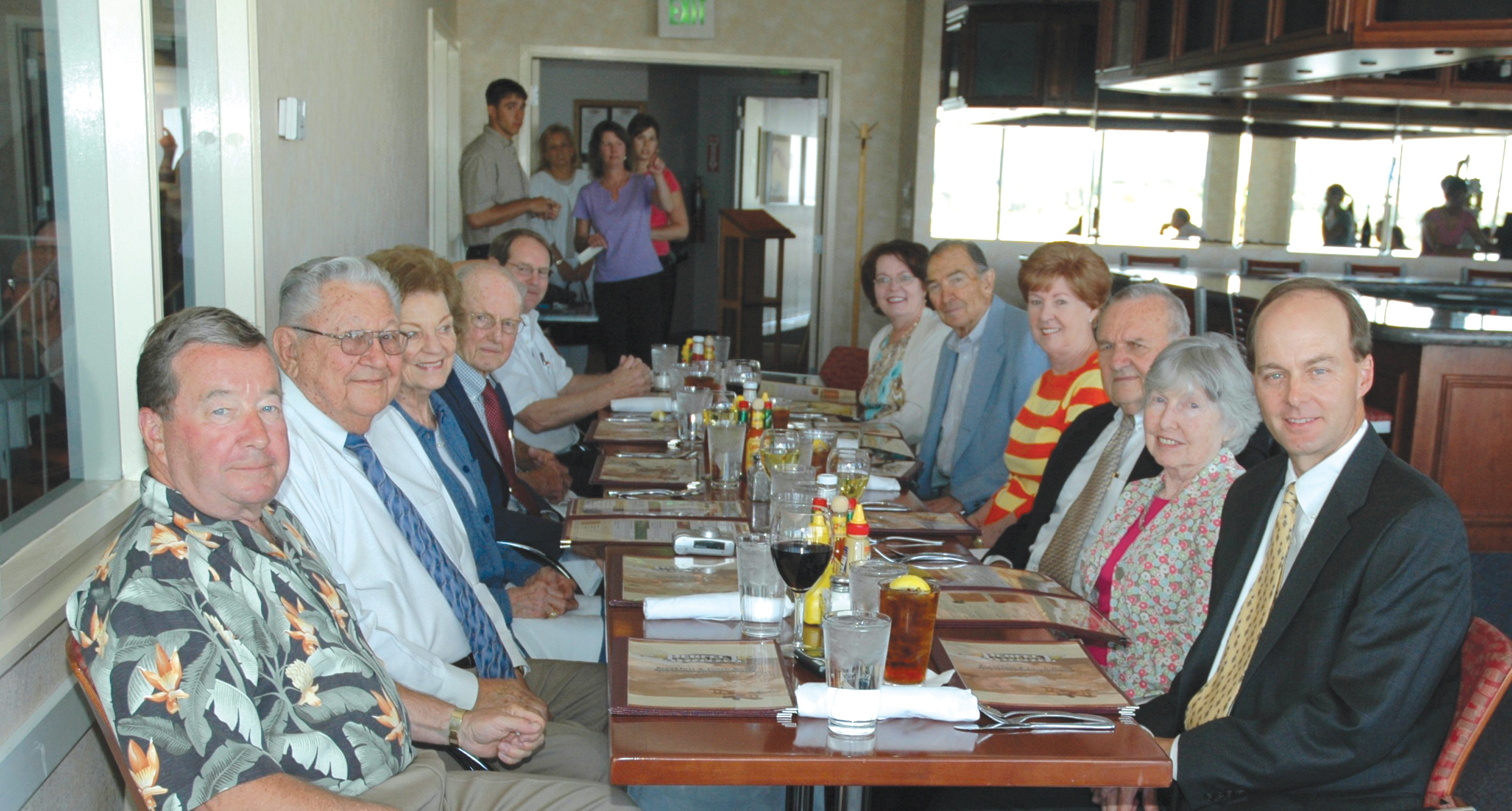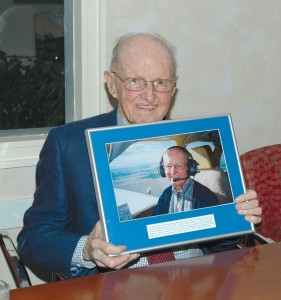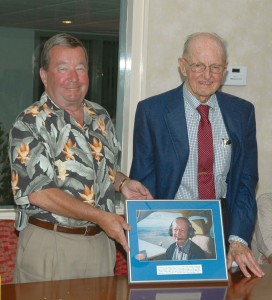By Di Freeze

From front L, clockwise: Jim Carter, former Clinton Aviation employee Ed Mehlin, Charlene and Lou Clinton, former Clinton employees Nick Nichols and Howard Morgan, Laura Nichols, Jay Warner, former Clinton employee Emily Howell Warner, William Bredar, Dor
For one group of people enjoying lunch at the Perfect Landing on June 1, it was a chance to reminisce about the past. What was unique about their reminiscing was that they were remembering events that happened over 35 years ago, right on the spot where the Denver jetCenter-based restaurant now stands.
Although reminiscing was a big part of the lunch, the real purpose for being there was to present Jim Carter, the owner of the Perfect Landing, with a special portrait. They’ve been taken down temporarily while the restaurant is being remodeled, but the pictures that normally grace the walls of this popular place to “refuel” will again soon be displayed. Included will be a picture of aviation pioneer Lou Clinton, taken by good friend and fellow Colorado Aviation Hall of Fame enshrinee Bill Bredar.
After World War II, Lou Clinton decided to go into what others considered a risky business. He and Ray Melberg, both former U.S. Army flight instructors, founded Clinton Aviation in 1944, to sell planes, as well as to train pilots. They started with three war-surplus PT-19s, a Rearwin Sportster and a Beech biplane, which they used for charter work at Stapleton Air Field.
Melberg, a pilot for Continental Airlines, was transferred out of state a year after they began. Grant Robertson came on board as vice president of the company. He zeroed in on the advertising end of the business, while Clinton, as president, focused on marketing.
Due to the shortage of available aircraft, they initially concentrated on getting their flight-training program off the ground. The school, which included courses in mountain flying and aerobatics, would eventually earn acclaim as being one of the best flight schools in the nation. United Airlines pilots trained there. More than 12,000 pilots would graduate from it over the next 30 years.
After becoming Colorado and Wyoming distributors for Cessna, Clinton Aviation set out to fulfill their commitment of selling 175 new aircraft over the next 18 months. The company soon received the first of yearly awards for being among the top 10 Cessna dealers in the U.S.
In later years, Clinton Aviation sold Aerostar, Citabria, Mitsubishi and Learjet aircraft as well. Clinton built the first and largest indoor aviation showroom in the nation. The company also displayed Cessnas in automobile showrooms, shopping centers, and at the National Western Stock Show.
Clinton’s staff included Ed Mehlin, sales manager and chief pilot; Nick Nichols, who started as a mechanic and later joined the sales team; and Emily Howell Warner, one of the school’s flight instructors, who went on to become, in 1973, the first woman hired by a U.S. scheduled airline carrier (Frontier Airlines) as a pilot in contemporary times. Those three, as well as Clinton, would all eventually be enshrined in the Colorado Aviation Hall of Fame.
Although Clinton Aviation thrived at Stapleton, he was concerned about major growth and the threat of restrictions being placed on general aviation at the airport. So, when he learned about an airport being built in Arapahoe County, he was interested.
After founding the Denver Tech Center, George Wallace, a pilot and mechanical engineer, began working with a group of people, including Arapahoe County commissioners, to get an airport approved for the county. Construction began in 1967 and Arapahoe County Airport (now Centennial Airport) opened in 1968.
After deciding he wanted to make the move, Clinton drew up a proposal and presented his bid as the airport’s sole FBO. It was accepted over two others.
Clinton had facilities built that included two unique octagonal buildings and one 10-sided building. A spectacular aircraft showroom occupied most of the space on the ground floor of the main building, and housed a flight school. A spiral staircase accessed offices that overlooked the display area. Offering a complete line of services, Clinton Aviation was soon recognized across the nation for its innovative design.
Clinton sold his flourishing company in 1974. The new owner, Robert D. Sutherland, didn’t fare as well, and the FBO shut its doors a few years later. The facility came to life again when Larry Ulrich left a 26-year career with Combs-Gates to form and develop an FBO with Terry Combs, in 1979.
After converting the building into an executive terminal, and building four jet-size hangars, Combs and Ulrich sold their FBO to Beechcraft in 1983. Two years later, Beechcraft sold their Salt Lake City and Denver FBOs to Linden and Neal Blue.
The Rocky Mountain JetCenters Network chain of award-winning FBOs now includes Denver jetCenter (East and West), Salt Lake jetCenter, Colorado jetCenter in Colorado Springs, and Fort Collins-Loveland jetCenter.













